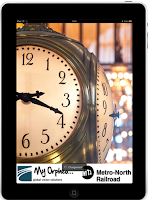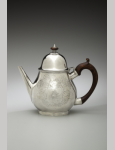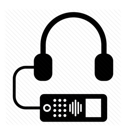Writing AD for Some -- or For all

The first audio description tours I wrote were designed specifically for people who are blind or have low vision.
For example, with Art Beyond Sight I produced an audio description tour of Grand Central Terminal in New York to accompany an existing general tour.
Listen below to one stop from that tour titled The Information Booth
Read a transcript of the audio here.
But today, whenever possible I write audio tours that serve sighted and blind audiences together. This can save money for a museum, and as an added bonus creates an inclusive experience that blind and sighted visitors can enjoy together.
My thinking began to evolve when I noticed that sighted people would sometimes pick up an audio tour player and listen to the audio description tour. My first reaction was they would object to having a voice describe what they could easily see. But to my surprise no visitor ever complained.
My thinking began to evolve when I noticed that sighted people would sometimes pick up an audio tour player and listen to the audio description tour. My first reaction was they would object to having a voice describe what they could easily see. But to my surprise no visitor ever complained.

This first happened at an audio description tour I wrote for a VSA exhibit in the Smithsonian International Gallery in Washington. VSA was the International Organization on Arts and Disabilty. I stood with an artist watching sighted people listening and I voiced my surprise. Her response: “People don’t like to read." Which I believe is correct for many visitors.
But I think there’s more to it. Having a voice describe what you’re looking at mimics the experience of most television watching in the U.S, especially local and national news and reality programs. Sighted people have come to expect descriptions of what their eyes can easily see.
That’s when I began attempting audio tours that combined traditional content for a sighted audience with a level of audio description for those with sight loss. Again, no one with vision ever questioned the writing.
But I think there’s more to it. Having a voice describe what you’re looking at mimics the experience of most television watching in the U.S, especially local and national news and reality programs. Sighted people have come to expect descriptions of what their eyes can easily see.
That’s when I began attempting audio tours that combined traditional content for a sighted audience with a level of audio description for those with sight loss. Again, no one with vision ever questioned the writing.

- Actually, one person did question me. The curator of a show on historical silver objects read my first draft script and asked, “Why do we have to tell people this teapot is twelve inches tall?” My answer had two parts. First, I reminded her that the tour was for both sighted and blind audiences. And second, I told her that in my experience such details help sighted visitors confirm their perceptions. Rather than resenting the audio description they appreciate it.
The best thing any audio tour can do is to help someone look more closely and carefully. An audio tour can focus attention, making for a richer experience, especially if a sighted visitor chooses not to read wall labels.

A sighted museum docent inadvertently confirmed the value of my writing approach. At a museum where I produced an audio tour of paintings and sculptures for both sighted and blind visitors, the docent told me she listened to the audio tour and gleaned new visual insights that she could use in her group tours with sighted visitors.
So now I advocate audio tours that address both audiences. The challenge is coming up with the correct balance of artistic or historical context and audio description, in a length that won’t bore the visitor. I must decide how much audio description is adequate for a person who can’t see the painting or artifact, and how to integrate it with the other information.
If there is a downside to this approach, it is that some people who are blind want more detailed audio description, and that is valid criticism. To answer that, a museum might add an optional "layer" of AD to a tour. After hearing an inclusive stop, the tour could, for example, prompt a visitor to "press 5 more a detailed audio description of this work." But in most cases I have found that inclusive audio description tours provide experiences that can be shared by both audiences, whether in a museum or on a web site.
**********
So now I advocate audio tours that address both audiences. The challenge is coming up with the correct balance of artistic or historical context and audio description, in a length that won’t bore the visitor. I must decide how much audio description is adequate for a person who can’t see the painting or artifact, and how to integrate it with the other information.
If there is a downside to this approach, it is that some people who are blind want more detailed audio description, and that is valid criticism. To answer that, a museum might add an optional "layer" of AD to a tour. After hearing an inclusive stop, the tour could, for example, prompt a visitor to "press 5 more a detailed audio description of this work." But in most cases I have found that inclusive audio description tours provide experiences that can be shared by both audiences, whether in a museum or on a web site.
**********